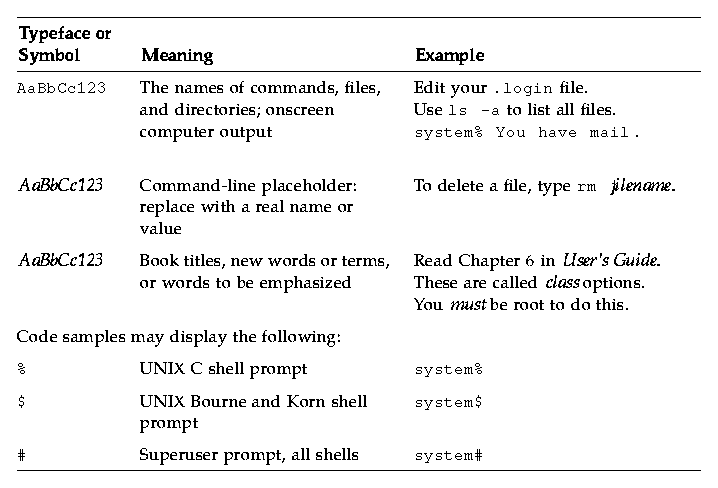




Common Desktop Environment: Desktop KornShell User's Guide
Preface
Contents of Chapter:
- Who Should Use This Guide
-
- How This Guide Is Organized
-
- Related Books
-
- What Typographic Changes and Symbols Mean
-
The Desktop KornShell User's Guide provides the information you need to create Motif applications with KornShell (kshell) scripts. In addition to the basic information you'll need to get started, several example scripts of increasing complexity are described. Throughout this guide the term dtksh means the Desktop KornShell.
Who Should Use This Guide
This guide is intended for programmers who want a quick and easy means of creating Motif applications, but don't have the time, knowledge, or inclination to use the C programming language. A good understanding of kshell programming, Motif, the Xt Intrinsics, and, to a lesser extent, Xlib is needed. An understanding of C would also be helpful.
How This Guide Is Organized
Chapter 1, "Introduction to Desktop KornShell," describes the basic information you need to begin writing Motif applications in dtksh scripts.
Chapter 2, "A Sample Script," describes two simple dtksh scripts. The first script creates a push button widget within a bulletin board widget. The second script expands the first by adding a callback for the push button.
Chapter 3, "Advanced Topics," describes more advanced topics pertaining to dtksh scripts.
Chapter 4, "A Complex Script," describes a much more complex script than either of the ones described in Chapter 2. This script creates a graphic interface to the find command.
Appendix A, "dtksh Commands," lists all the dtksh commands.
Appendix B, "dtksh Convenience Functions," contains man pages for commands or functions that are not documented elsewhere.
Appendix C, "The script_find Script," contains the complete listing of the complex script described in Chapter 4.
Related Books
The following books provide information on kshell programming, Motif, the Xt Intrinsics, and Xlib:
- Desktop KornShell Graphical Programming For the Common Desktop Environment Version 1.0, by J. Stephen Pendergrast, Jr., published by Addison-Wesley, Reading, MA 01867.
- The New KornShell Command and Programming Language, by Morris I. Bolsky and David G. Korn, published by Prentice-Hall, Englewood Cliffs, NJ 07632.
- KornShell Programming Tutorial, by Barry Rosenberg, published by Addison-Wesley, Reading, MA 01867.
- OSF/Motif Programmer's Guide, Open Software Foundation, 11 Cambridge Center, Cambridge, MA 02142, published by Prentice-Hall, Englewood Cliffs, NJ 07632.
- OSF/Motif Programmer's Reference, Open Software Foundation, 11 Cambridge Center, Cambridge, MA 02142, published by Prentice-Hall, Englewood Cliffs, NJ 07632.
- OSF/Motif Reference Guide, by Douglas A. Young, published by Prentice-Hall, Englewood Cliffs, NJ 07632.
- Mastering OSF/Motif Widgets (Second Edition), by Donald L. McMinds, published by Addison-Wesley, Reading, MA 01867
- The X Window System Programming and Applications with Xt OSF/Motif Edition, by Douglas A. Young, published by Prentice-Hall, Englewood Cliffs, NJ 07632.
- The Definitive Guides to the X Window System, Volume 1: Xlib Programming Manual, by Adrian Nye, published by O'Reilly and Associates, Sebastopol, CA 95472.
- The Definitive Guides to the X Window System, Volume 2: Xlib Reference Manual, edited by Adrian Nye, published by O'Reilly and Associates, Sebastopol, CA 95472.
- The Definitive Guides to the X Window System, Volume 3: X Window System User's Guide, by Valerie Quercia and Tim O'Reilly, published by O'Reilly and Associates, Sebastopol, CA 95472.
- The Definitive Guides to the X Window System, Volume 4: X Toolkit Intrinsics Programming Manual, by Adrian Nye and Tim O'Reilly, published by O'Reilly and Associates, Sebastopol, CA 95472.
- The Definitive Guides to the X Window System, Volume 5: X Toolkit Intrinsics Reference Manual, edited by Tim O'Reilly, published by O'Reilly and Associates, Sebastopol, CA 95472.
- The Definitive Guides to the X Window System, Volume 6: Motif Programming Manual, by Dan Heller, published by O'Reilly and Associates, Sebastopol, CA 95472.
What Typographic Changes and Symbols Mean
The following table describes the type changes and symbols used in this book.
Table P-1 Typographic Conventions






Generated with CERN WebMaker











